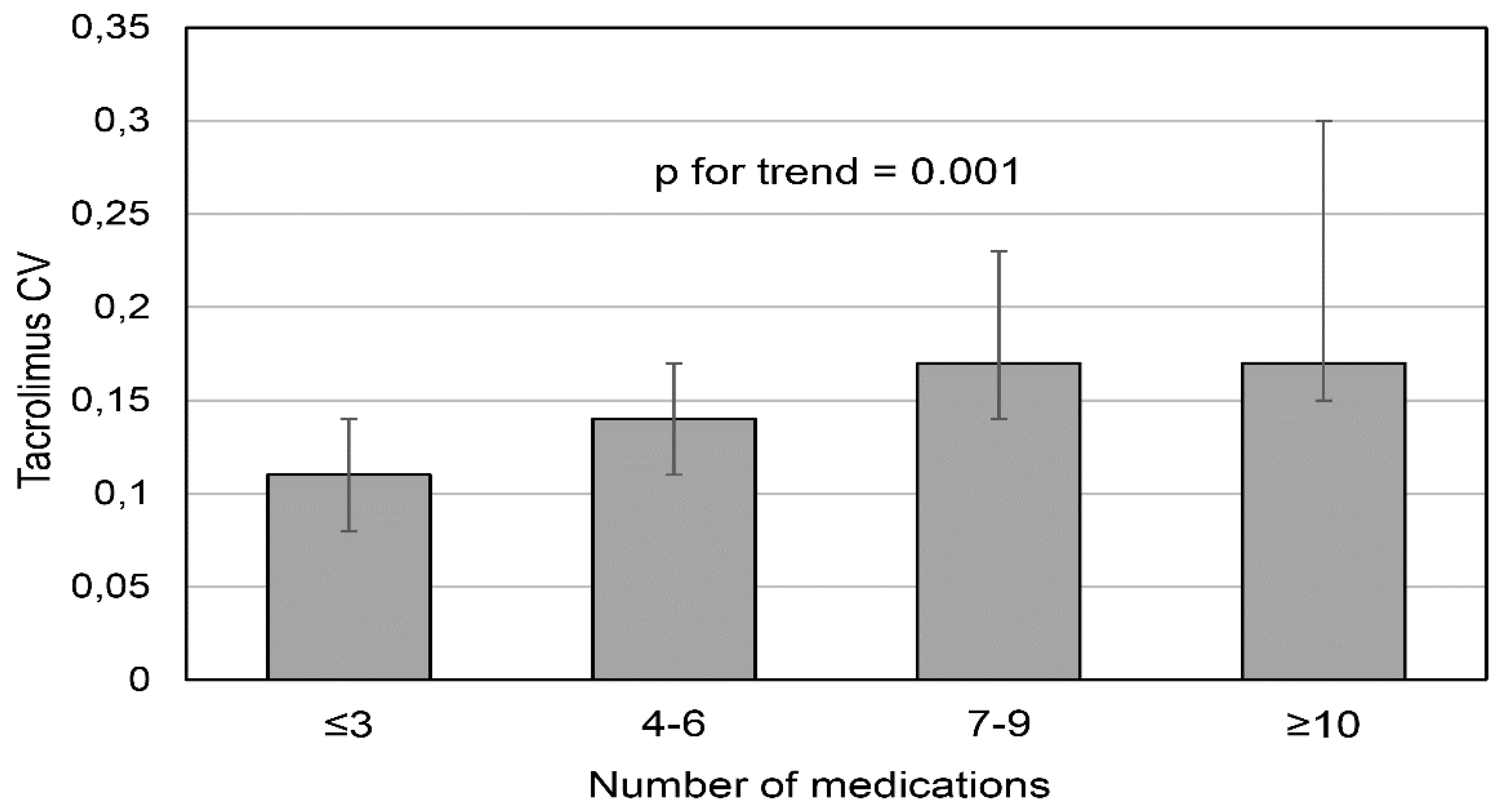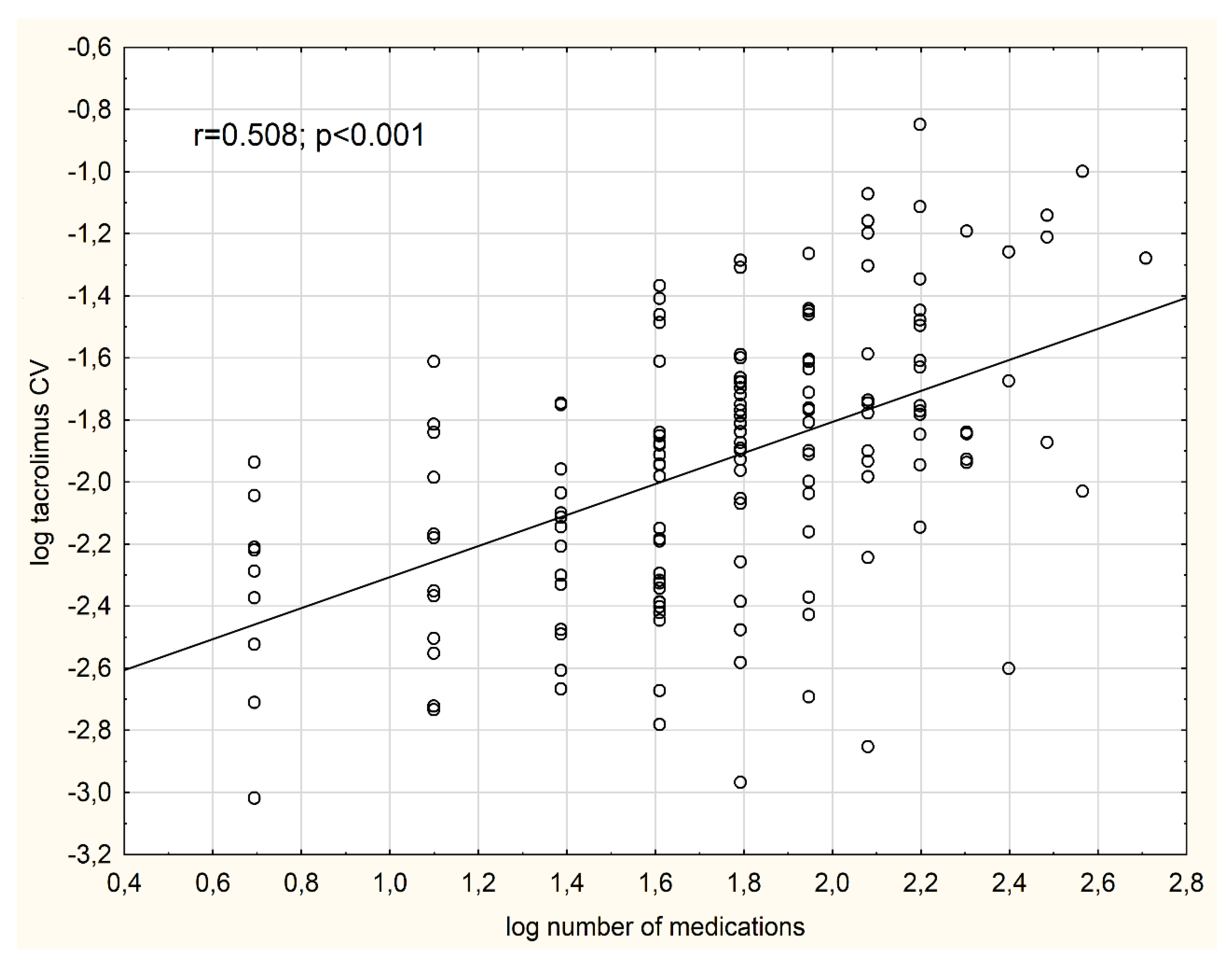Number of Regularly Prescribed Drugs and Intrapatient Tacrolimus Trough Levels Variability in Stable Kidney Transplant Recipients
Abstract
1. Introduction
2. Materials and Methods
2.1. Study Group
2.2. Data and Statistical Analysis
3. Results
3.1. Tacrolimus IPV and the Number of Regularly Prescribed Medications
3.2. Tacrolimus IPV for Two Different Tacrolimus Formulations
3.3. Co-Medication and Tacrolimus IPV
4. Discussion
5. Conclusions
Author Contributions
Funding
Conflicts of Interest
References
- Wolfe, R.A.; Ashby, V.B.; Milford, E.L.; Ojo, A.O.; Ettenger, R.E.; Agodoa, L.Y.; Held, P.J.; Port, F.K. Comparison of mortality in all patients on dialysis, patients on dialysis awaiting transplantation, and recipients of a first cadaveric transplant. N. Engl. J. Med. 1999, 341, 1725–1730. [Google Scholar] [CrossRef] [PubMed]
- Lim, M.A.; Kohli, J.; Bloom, R.D. Immunosuppression for kidney transplantation: Where are we now and where are we going? Transplant. Rev. (Orlando) 2017, 31, 10–17. [Google Scholar] [CrossRef] [PubMed]
- Humar, A.; Hassoun, A.; Kandaswamy, R.; Payne, W.D.; Sutherland, D.E.; Matas, A.J. Immunologic factors: The major risk for decreased long-term renal allograft survival. Transplantation 1999, 68, 1842–1846. [Google Scholar] [CrossRef] [PubMed]
- McDonald, S.; Russ, G.; Campbell, S.; Chadban, S. Kidney transplant rejection in Australia and New Zealand: Relationship between rejection and graft outcome. Am. J. Transplant. 2007, 7, 1201–1208. [Google Scholar] [CrossRef] [PubMed]
- Gaynor, J.J.; Ciancio, G.; Guerra, G.; Sageshima, J.; Roth, D.; Goldstein, M.J.; Chen, L.; Kupin, W.; Mattiazzi, A.; Tueros, L.; et al. Lower tacrolimus trough levels are associated with subsequently higher rate rejection risk during the first 12 months after kidney transplantation. Transplant. Int. 2015, 29, 216–226. [Google Scholar] [CrossRef]
- Borra, L.C.P.; Roodnat, J.I.; Kal, J.A.; Mathot, R.A.A.; Weimar, W.; van Gelder, T. High within-patient variability in the clearance of tacrolimus is a risk factor for poor long-term outcome after kidney transplantation. Nephrol. Dial. Transplant. 2010, 25, 2757–2763. [Google Scholar] [CrossRef]
- Vanhove, T.; Vermeulen, T.; Annaert, P.; Lerut, E.; Kuypers, D.R.J. High intrapatient variability of tacrolimus concentrations predict accelerated progression of chronic histologic lesions in renal recipients. Am. J. Transplant. 2016, 16, 2954–2963. [Google Scholar] [CrossRef]
- D’Arcy, P.F. Iatrogenic disease: A hazard of multiple drug therapy. R. Soc. Health J. 1976, 96, 277–283. [Google Scholar]
- O’Hare, A.M.; Choi, A.I.; Bertenthal, D.; Bacchetti, P.; Garg, A.X.; Kaufman, J.S.; Walter, L.C.; Mehta, K.M.; Steinman, M.A.; Allon, M.; et al. Age affects outcomes in chronic kidney disease. J. Am. Soc. Nephrol. 2007, 18, 2758–2765. [Google Scholar] [CrossRef]
- Hardinger, K.L.; Hutcherson, T.; Preston, D.; Murillo, D. Influence of pill burden and drug cost on renal function after transplantation. Pharmacotherapy 2012, 32, 427–432. [Google Scholar] [CrossRef]
- Adhikari, U.R.; Taraphder, A.; Hazra, A.; Das, T. Pill burden does not influence compliance with oral medication in recipients of renal transplant. Indian J. Pharmacol. 2016, 48, 21–25. [Google Scholar] [PubMed]
- Knoll, G.A. Kidney transplantation in the older adult. Am. J. Kidney Dis. 2013, 61, 790–797. [Google Scholar] [CrossRef] [PubMed]
- Troen, A.M.; Scott, T.M.; D’Anci, K.E.; Moorthy, D.; Dobson, B.; Rogers, G.; Weiner, D.E.; Levey, A.S.; Dallal, G.E.; Jacques, P.F.; et al. Cognitive dysfunction and depression in adult kidney transplant recipients: Baseline findings from the FAVORIT Ancillary Cognitive Trial (FACT). J. Renal Nutr. 2012, 22, 268–276. [Google Scholar] [CrossRef] [PubMed]
- Martinez-Sanchis, S.; Consuelo Bernal, M.; Montagud, J.V.; Candela, G.; Crespo, J.; Sancho, A.; Pallardó, L.M. Effects of immunosuppressive drugs on the cognitive functioning of renal transplant recipients: A pilot study. J. Clin. Exp. Neuropsychol. 2011, 33, 1016–1024. [Google Scholar] [CrossRef] [PubMed]
- Stifft, F.; Stolk, L.M.L.; Undre, N.; van Hooff, J.P.; Christiaans, M.H.L. Lower variability in 24-hour exposure during once-daily compared to twice-daily tacrolimus formulation in kidney transplantation. Transplantation 2014, 97, 775–780. [Google Scholar] [CrossRef] [PubMed]
- Backman, L.; Persson, C.A. An observational study evaluating tacrolimus dose, exposure, and medication adherence after conversion from twice- to once-daily tacrolimus in liver and kidney transplant recipients. Ann. Transplant. 2014, 19, 138–144. [Google Scholar]
- Shuker, N.; van Gelder, T.; Hesselink, D.A. Intra-patient variability in tacrolimus exposure: Causes, consequences for clinical management. Transplant. Rev. 2015, 29, 78–84. [Google Scholar] [CrossRef]
- Anderson, K.; Willmore, C.; Doran, E.; Oki, N.; Vonnahme, J.; Gates, B.J. Cognitive and literacy screening as predictors of ability to fill a pillbox using two pillbox assessment scoring methods. Consult. Pharm. 2014, 29, 304–316. [Google Scholar] [CrossRef]
- Jiron, M.; Pate, V.; Hanson, L.C.; Lund, J.L.; Funk, M.J.; Sturmer, T. Trends in prevalence and determinants of potentially inappropriate prescribing in the United States: 2007 to 2012. J. Am. Geriatr. Soc. 2016, 64, 788–797. [Google Scholar] [CrossRef]
- Ortiz, F.; Aronen, P.; Koskinen, P.K.; Malmstrom, R.K.; Finne, P.; Honkanen, E.O.; Sintonen, H.; Roine, R.P. Health-related quality of life after kidney transplantation: Who benefits the most? Transplant. Int. 2014, 27, 1143–1151. [Google Scholar] [CrossRef]
- Belaiche, S.; Decaudin, B.; Dharancy, S.; Gautier, S.; Noel, C.; Odou, P.; Hazzan, M. Factors associated with the variability of calcineurin inhibitor blood levels in kidney recipients grafted for more than 1 year. Fundam. Clin. Pharmacol. 2018, 32, 88–97. [Google Scholar] [CrossRef]
- Goodall, D.L.; Willicombe, M.; McLean, A.G.; Taube, D. High intrapatient variability of tacrolimus levels and outpatient clinic nonattendance are associated with inferior outcomes in renal transplant patients. Transplant. Direct 2017, 3, e192. [Google Scholar] [CrossRef] [PubMed]
- Muduma, G.; Odeyemi, I.; Pollock, R.F. Evaluating the economic implications of non-adherence and antibody-mediated rejections in renal transplant recipients: The role of once-daily tacrolimus in the UK. J. Med. Econ. 2015, 18, 1050–1059. [Google Scholar] [CrossRef] [PubMed]
- Wu, M.J.; Chen, C.Y.; Chen, C.H.; Wu, W.P.; Cheng, C.H.; Yu, D.M.; Chuang, Y.W.; Shu, K.H. Lower variability of tacrolimus trough concentration after conversion from Prograf to Advagraf in stable kidney transplant patients. Transplantation 2011, 92, 648–652. [Google Scholar] [CrossRef] [PubMed]
- Shuker, N.; Cadogan, M.; van Gelder, T.; Roodnat, J.I.; Kho, M.M.L.; Weimar, W.; Hesselink, D.A. Conversion from twice daily to once-daily tacrolimus does not reduce intrapatient variability in tacrolimus exposure. Ther. Drug Monit. 2015, 37, 262–269. [Google Scholar] [CrossRef] [PubMed]
- Zaltzman, J.S.; Lai, V.; Schulz, M.Z.; Moon, K.H.; Cherney, D.Z. A randomized cross-over comparison of short-term exposure of once-daily extended release tacrolimus and twice-daily tacrolimus on renal function in healthy volunteers. Transplant. Int. 2014, 27, 1294–1302. [Google Scholar] [CrossRef] [PubMed]



| Study Subgroups Divided According to the Number of Medications | p | ||||
|---|---|---|---|---|---|
| Subgroup 1 | Subgroup 2 | Subgroup 3 | Subgroup 4 | ||
| ≤3 (N = 23) | 4–6 (N = 65) | 7–9 (N = 50) | ≥10 (N = 14) | ||
| Age (years) | 47.7 (42.9–52.6) | 47.7 (44.3–51.1) | 51.1 (47.7–54.5) | 55.4 (50.6–60.2) | 0.13 |
| Gender (M/F) | 11/12 | 39/26 | 23/27 | 6/8 | 0.39 *** |
| BMI (kg/m2) | 25.8 (23.8–27.8) | 26.0 (25.1–26.9) | 28.8 (27.4–30.3) | 31.4 (28.8–34.0) | <0.001 |
| Dialysis vintage (months) * | 31 (14–42) | 29 (18–48) | 30 (23–40) | 24 (10–44) | 0.96 ** |
| Time from transplantation (years) | 6.0 (4.6–7.4) | 6.3 (5.4–7.1) | 5.6 (4.8–6.5) | 6.2 (4.7–7.8) | 0.74 |
| eGFR (mL/min/1.73m2) | 70.6 (63.8–77.3) | 60.8 (55.2–66.4) | 55.5 (49.7–61.4) | 49.3 (37.5–61.1) | <0.01 |
| Hypertension (n (%)) | 7 (30.4) | 51 (78.5) | 49 (98) | 12 (85.7) | <0.001 |
| CVD (n (%)) | 2 (9) | 6 (9) | 8 (16) | 5 (36) | 0.02 for trend *** |
| Diabetes (n (%)) | 2 (9) | 10 (15) | 15 (30) | 7 (50) | <0.001 for trend *** |
| CCI * | 3 (2–4) | 3 (2–5) | 4 (3–5) | 5 (3–6) | <0.01 ** |
| Number of medications * | 3 (2–3) | 5 (5–6) | 8 (7–9) | 11 (10–12) | <0.001 ** |
| Total weekly pill burden | 40 (33–47) | 57 (54–61) | 81 (77–85) | 111 (96–126) | <0.001 |
| Dosing frequency per day * | 2 (2–2) | 2 (2–3) | 3 (2–4) | 5 (4–5) | <0.001 ** |
| Renally excreted drugs * (%) | 58.3 (50.0–66.7) | 50.0 (40.0–66.7) | 55.6 (50.0–71.4) | 59.2 (50.0–63.6) | 0.95 ** |
| Study Groups According to the Tacrolimus Formulation | p | ||
|---|---|---|---|
| Prograf (N = 70) | Advagraf (N = 82) | ||
| Age (years) | 49.2 (46.1–52.4) | 49.8 (47.1–52.4) | 0.78 |
| Gender (M/F) | 36/34 | 43/39 | 0.90 *** |
| BMI (kg/m2) | 26.3 (25.4–27.2) | 28.3 (27.2–29.5) | <0.01 |
| Dialysis vintage (months) * | 34 (19–48) | 25 (15–38) | 0.55 ** |
| Time after transplantation (years) | 6.2 (5.4–7.0) | 5.9 (5.2–6.5) | 0.52 |
| eGFR (mL/min/1.73m2) | 62.5 (57.2–67.7) | 56.9 (52.3–61.4) | 0.11 |
| Hypertension (n (%)) | 55 (78.6) | 64 (78.1) | 0.94 |
| CVD (n (%)) | 11 (15.7) | 10 (12.2) | 0.53 *** |
| Diabetes (n (%)) | 11 (15.7) | 23 (28.1) | 0.07 *** |
| CCI * | 3 (2–4) | 4 (3–5) | 0.06 ** |
| Number of medications * | 6 (4–7) | 6 (5–8) | <0.05 ** |
| Total weekly pill burden | 69.4 (63.7–75.0) | 65.6 (59.6–71.5) | 0.36 |
| Dosing frequency per day * | 3 (2–3) | 3 (2–3) | 0.37 ** |
© 2020 by the authors. Licensee MDPI, Basel, Switzerland. This article is an open access article distributed under the terms and conditions of the Creative Commons Attribution (CC BY) license (http://creativecommons.org/licenses/by/4.0/).
Share and Cite
Giza, P.; Ficek, R.; Dwulit, T.; Chudek, J.; Woźniak, I.; Więcek, A.; Kolonko, A. Number of Regularly Prescribed Drugs and Intrapatient Tacrolimus Trough Levels Variability in Stable Kidney Transplant Recipients. J. Clin. Med. 2020, 9, 1926. https://doi.org/10.3390/jcm9061926
Giza P, Ficek R, Dwulit T, Chudek J, Woźniak I, Więcek A, Kolonko A. Number of Regularly Prescribed Drugs and Intrapatient Tacrolimus Trough Levels Variability in Stable Kidney Transplant Recipients. Journal of Clinical Medicine. 2020; 9(6):1926. https://doi.org/10.3390/jcm9061926
Chicago/Turabian StyleGiza, Piotr, Rafał Ficek, Tomasz Dwulit, Jerzy Chudek, Iwona Woźniak, Andrzej Więcek, and Aureliusz Kolonko. 2020. "Number of Regularly Prescribed Drugs and Intrapatient Tacrolimus Trough Levels Variability in Stable Kidney Transplant Recipients" Journal of Clinical Medicine 9, no. 6: 1926. https://doi.org/10.3390/jcm9061926
APA StyleGiza, P., Ficek, R., Dwulit, T., Chudek, J., Woźniak, I., Więcek, A., & Kolonko, A. (2020). Number of Regularly Prescribed Drugs and Intrapatient Tacrolimus Trough Levels Variability in Stable Kidney Transplant Recipients. Journal of Clinical Medicine, 9(6), 1926. https://doi.org/10.3390/jcm9061926





